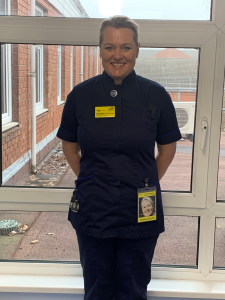IWD 2021: Amanda Whileman
Amanda Whileman – Senior Matron in Clinical Research at Chesterfield Royal Hospital

During Covid-19, research has been thrown into sharp focus and Amanda has led her team (small by research standards) through 10 urgent public health studies so far. The most prominent of these, with regards the difference it has made has to be the ‘RECOVERY’ trial. This study has evidenced the efficacy of dexamethasone and tocilizumab. These drugs have proven effective in reducing mortality in patients with Covid-19. It’s been a huge focus, and success for the team says Amanda: “I am immensely proud of being instrumental in the set-up, organisation and delivery of such an iconic trial. I know that the work we did and continue to do, not only benefits the patients but gave staff hope. A respiratory nurse described the moment the research team walked on the ward as a ‘lighthouse’, giving her and her colleagues hope that something could be done for their patients.”
What inspired you to work for the NHS?
“When I was a child I was quite poorly with asthma and in and out of hospital in Wales, and by the age of 10 I knew I wanted to be a nurse and I wanted to help people as they’d helped me. And I did. I was very determined. None of my family are nurses – I wanted to be a children’s nurse but when I was doing my A-Levels I worked at a Nursing Home to get some money and loved adults and care. I came to do my adult training in Chesterfield through the University of Sheffield and have never left. I did my first five and half years on a cardiology ward, onto Coronary Care for five years and then rehab and then research.
“My passion for cardiology initially drew me to clinical research and the prospect of finding the answers my patients desperately needed. I found clinical research nursing very different and it took me a year to adapt. However, it was the best career move I ever made. I love the constant challenge research brings. There is always something to learn and it keeps me on my toes every day.”
What does a typical day look like
“A typical day is variable and challenging! Some days are purely clinical, giving iron infusions or seeing Covid-19 positive patients with regards to clinical trials, other days are spent supporting with training, staff mental health support, sharing knowledge and experience. I spend time in meetings, collaborating with other areas, exploring new ways of working to improve on what we already do and assessing our capacity and capability for new studies. Often my days are a mixture of all these things.”
What do you enjoy most about your job?
“I do enjoy the variety without a doubt. No two days are the same. I take pride in being a good role model to the members of the team. My moto has always been to never expect anyone to do anything I wasn’t prepared to do myself. Ultimately, research and the prospect of finding new and effective treatments for our patients is very exciting!”
Tell us your most memorable moment or what you’re most proud of
“There have been many proud and memorable moments but the most vivid has to be around the pandemic and the way in which the team adapted and completely changed the way we work. I was completely overwhelmed with the comradery and how the team achieved amazing results and supported each other. Having our achievements recognised by the chief nursing officer, Ruth May and receiving the CNO award was most certainly a very proud moment for myself and my team.
“I’ve learned a lot about myself through my career – I am determined; I was a widow at 29 but I was determined to be successful for my kids as I was on my own. I remarried and Gary has really encouraged and believed in me. He thinks I can do anything and he’s supported me to progress to where I am now.
“I look back and never thought that I would be doing what I am but I would say to my younger self just be prepared for the hard work. Nursing is not a job, it’s a vocation. I love it!”
